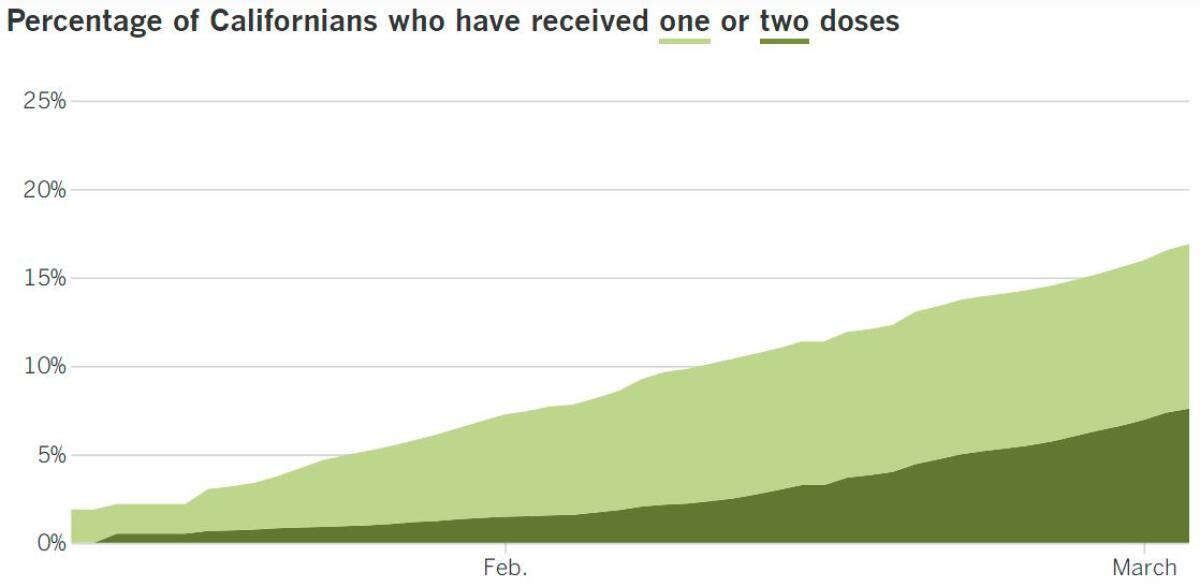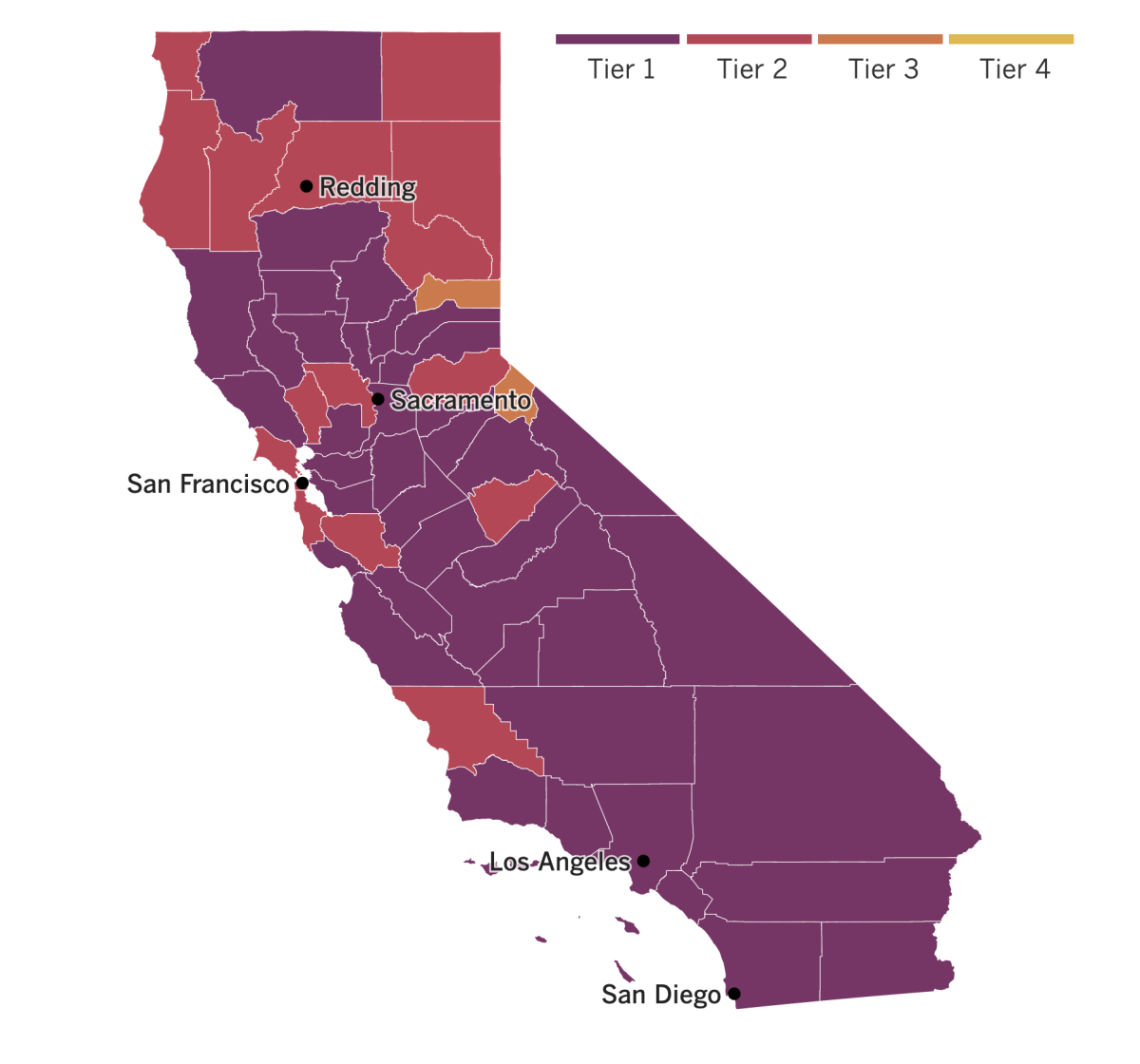Coronavirus Today: California changes course. Again.
Good evening. I’m Thuc Nhi Nguyen, and it’s Thursday, March 4. Here’s what’s happening with the coronavirus in California and beyond.
Buckle up. California’s vaccination plan is taking another sharp turn.
The state will now devote 40% of available COVID-19 vaccines to residents of the most disadvantaged areas, officials announced Wednesday night. The major shift in policy is intended to slow the spread of the coronavirus, especially in communities that have been disproportionately affected by the pandemic, my colleagues report.
The latest change comes amid mounting evidence that Latino and Black communities are falling behind white and Asian ones in getting access to the COVID-19 vaccines, even though they have had the highest rates of infection.
Currently, 1.6 million doses have been administered to people who live in the state’s hardest-hit communities. In Southern California, these areas include South L.A., the Eastside, Koreatown, Chinatown, Compton, southeast L.A. County, the eastern San Fernando Valley, Santa Ana and a number of heavily Latino communities along the Interstate 10 corridor between Pomona and San Bernardino.
Once 2 million doses have been administered in the targeted communities across California, the state will ease up on the requirements for moving through its four-tier reopening plan by allowing counties with a daily new case rate of up to 10 per 100,000 people to become eligible for the red tier. Currently, the threshold to move out of the most-restrictive purple tier is 7.0 cases per 100,000 people.
How much of a change would that be? Well, under the old standard, no counties in Southern California qualify for the red tier. Under the new one, L.A., Orange and San Bernardino counties would.
Although she wasn’t privy to the specifics of the state’s proposal, Los Angeles County Public Health Director Barbara Ferrer said that taking vaccinations into account for the tier assignments makes sense.
“We said that all along: Vaccines are, in fact, a game changer,” she said Wednesday. “But you have to have lots and lots of people getting vaccinated before it’s going to make a big difference.”
In L.A. County, 1.2 million essential workers became eligible for the vaccine this week. Millions more with underlying health problems and disabilities will join them on March 15.
But the new strategy means that 50% of the state’s doses will already be accounted for (that includes the 10% allotted for education workers). Officials are hoping for a major boost in supplies soon.
By the numbers
California cases, deaths and vaccinations as of 6:58 p.m. Thursday:

Track California’s coronavirus spread and vaccination efforts — including the latest numbers and how they break down — with our graphics.

Across California
This news won’t come as a shock to you, dear reader, but I’m sorry to have to say it: California’s vaccine appointment system leaves a lot to be desired.
Now local officials are admitting it too, my colleagues report. Ferrer acknowledged that the state’s My Turn system doesn’t account for each county‘s eligibility requirements, and the fact that it’s web-based makes it inaccessible for many people who need to use it.
The system’s various shortcomings have only exacerbated the already difficult process of immunizing the most vulnerable Californians because it offers no way to restrict access to appointments. For instance, Ferrer said the county wanted to hold exclusive clinics for food and agriculture workers on Tuesdays and Thursdays, but officials couldn’t ensure that appointments would only go to people who were eligible. A previous attempt by the state to limit appointments to members of at-risk Black and Latino communities backfired when access codes were used by outsiders.
Improvements are coming, Ferrer said, adding that she hopes by the end of March, people will be able to easily make appointments via telephone if they can’t use the My Turn website.
In addition to the unreliable appointment system, the state is still contending with supply issues. Limited quantities forced a major health provider in Northern California to cancel 40,000 second-dose vaccine appointments this week and postpone 50,000 more.
With a promise from the state that there would be enough supplies for second shots, Sutter Health focused on administering first doses at mass vaccination sites, a spokesperson said. But the second doses didn’t show up. The health system expects to receive 30,000 doses next week and 30,000 more the following week, but it still won’t be enough to cover all the appointments.
One small group that does have access to a vaccine are great apes in the San Diego Zoo. Four orangutans and five bonobos have received experimental COVID-19 vaccines, and the zoo plans to immunize three more bonobos and a gorilla soon. These species, along with chimpanzees, are the closest cousins to humans, placing them at risk of contracting a virus that has spread rapidly from person to person.
Eight gorillas became infected with the coronavirus in January after being exposed through a zoo employee who showed no symptoms and wore protective equipment. Zoetis, an animal health company that was once part of Pfizer, is developing a vaccine for animals.
For counties in the purple tier, zoos are only allowed to open outdoors with some modifications. But with case rates declining, many counties are inching toward the red tier. To lean into the gradual reopening process, Universal Studios Hollywood is letting fans buy food, shop and wander throughout most of the 415-acre park on weekends.
Large amusement parks can’t open until they’re in the yellow tier — the least restrictive level in California’s plan to reopen the economy — and even then, they are only allowed to be at 25% capacity. In the meantime, parks are testing out pared-down formats. Starting March 12, Universal Studios will open most areas of the park on Fridays, Saturdays and Sundays for food and shopping, similar to what Disney California Adventure Park will start March 18. Knott’s Berry Farm has a “Taste of Boysenberry Festival” event starting March 5.
Another thing people can (cautiously) look forward to is the return of the Rose Parade, which organizers are planning to revive in 2022.
This year, the pandemic forced the New Year’s Day spectacle to be canceled for the first time in 75 years. The theme was going to be “Dream. Believe. Achieve.” The message will stay the same for next year, but the focus will shift from education to celebrating the perseverance of essential workers and healthcare professionals during the pandemic, organizers said.
To keep the spread of the coronavirus down and stay on track for more events like the parade, you’re now advised to wear two masks. The California Department of Public Health released new guidance Thursday, recommending that “a close-fitting cloth mask can be worn on top of a surgical/disposable mask to improve the seal of the mask to the face.”
Layering more than two masks could make it difficult to breathe and is not advised. Neither is wearing two medical masks, or wearing a medical mask on top of a KN95 or an N95, the state said.


See the latest on California’s coronavirus closures and reopenings, and the metrics that inform them, with our tracker.
Consider subscribing to the Los Angeles Times
Your support helps us deliver the news that matters most. Become a subscriber.
Around the nation and the world
Dr. John Wesley Patton III enthusiastically publicizes the moment he got vaccinated on Instagram. Dr. Magdala Chery uses the social media platform to tell Black and brown community members that she doesn’t want them to lose their parents to COVID-19 like she did.
But the posts from Black doctors don’t seem to make a dent in generations of suspicion toward the medical establishment, my colleague Erin B. Logan reports.
Experts say Black people’s mistrust in medicine and government stretches back to the days when white doctors exploited the bodies of enslaved people and called it scientific research. Black people were the subjects of unethical experiments, including the infamous Tuskegee syphilis study, and were discouraged from becoming physicians. Years of racial inequality and police brutality are yet another reason to be skeptical.
“We’ve still not received justice for Breonna Taylor or George Floyd,” said Nailah Thompson, a financial advisor in Sacramento who has no plans to get vaccinated. “If the government is concerned about Black lives, it should not just be to end this pandemic.”
Black people are among those most affected by the pandemic, but less than 30% of Black Californians said earlier this year they would probably or definitely get vaccinated. For those who do want the shots, access has been uneven. Codes intended to target Black communities were co-opted by outsiders, including white, work-from-home types who face far less risk than front-line essential workers.
“They blame Black people for mistrust as if the onus of trust is on us when it’s on the institutions,” said Chery, a fellow at Harvard’s Commonwealth Fund Fellowship in Minority Health Policy. She got vaccinated, but she understands why people like Thompson remain hesitant: “If the government won’t tell the truth about the harm they’ve done ... why should Black people believe the government cares when it comes to the vaccine?”
In Europe, officials are debating whether vaccine “passports” could help motivate people to get inoculated. In theory, a government-issued proof of vaccination could give people permission to engage in a range of coveted activities — going to concerts, traveling by airplane or eating inside restaurants.
But many people fear that a passport system could create “a two-tier society,” said Sam Grant of the advocacy group Liberty, which campaigns for civil liberties. “Some people can access support and freedoms, while others are shut out,” he said.
The passes are still a hypothetical idea in most places, except for Israel, which is vaccinating its population faster than any country in the world. There, vaccinated people or people who have recovered from the disease can download a “green pass” to their smartphones. For now, it’s the only way to get into concert halls, theaters and major soccer games.
In the United States, sporting events have been mostly without fans since last summer, when leagues built bubbles and devised elaborate plans to hold games amid the pandemic. The systems made professional athletes some of the most-tested people in the U.S. Now researchers are taking advantage of the unusual situation to answer a key question about COVID-19’s long-term impacts on the body.
A new study conducted by major professional sports leagues suggests that heart inflammation is uncommon in pro athletes who have had mostly mild cases of COVID-19. Most don’t need to be sidelined as a result of their illnesses, the researchers reported in the journal JAMA Cardiology.
The results are not definitive, experts from outside the leagues say, and more independent research is needed. But the study is the largest to date to examine the scope of the problem. A coronavirus infection can cause inflammation in many organs, including the heart.
That’s why many leagues required athletes who tested positive for the virus to undergo cardiac testing before they were allowed to return to play. The research involved almost 800 professional athletes who play football, hockey, soccer, baseball and basketball and tested positive for coronavirus infections before October.
As you would expect for a group of young, healthy individuals, none of the players developed severe cases of COVID-19. Almost 4% of the athletes had abnormal results on heart tests after they recovered, but subsequent MRI exams found heart inflammation in less than 1% of the athletes. Whether their heart problems were caused by the virus is unknown, although the researchers think that is likely.
Your questions answered
Today’s question comes from a reader who wants to know: Can I improve the effectiveness of the Johnson & Johnson vaccine by getting a booster shot of the Pfizer or Moderna vaccine?
The reader who submitted this question noted that the Johnson & Johnson vaccine, which was authorized for emergency use over the weekend, was found to be 66% effective at preventing COVID-19, while the Pfizer-BioNTech and Moderna offerings were at least 94% effective in their clinical trials.
But experts are urging Americans not to fixate on the difference in those numbers. With a growing number of coronavirus variants turning up, including some that could be more contagious, officials say the most important thing is to protect yourself now by getting the first vaccine available to you.
There’s no reason to be picky, either. The clinical trial results for the three vaccines don’t provide an apples-to-apples comparison on efficacy rates because they were tested in different circumstances. For example, Pfizer and Moderna finished their trials before many of the new variants had spread much, including the one from South Africa that is more resistant to vaccines.
Health officials believe all of the vaccines, when taken as directed, are equally effective at preventing severe cases of COVID-19. For that reason, seeking additional shots is not advised.
Per the Centers for Disease Control and Prevention: “People are not recommended to receive more than one complete COVID-19 vaccination series.”
Earlier this week, I answered a question about mixing-and-matching doses of the Pfizer and Moderna vaccines. Although British scientists are studying the potential benefits of pairing different vaccines, it’s not recommended at this time because there’s no data yet to support it.
Similarly, the CDC says the safety and efficacy of using the J&J vaccine after the Pfizer or Moderna vaccine — a scenario that’s the reverse of the reader’s question — have not been established. However, there’s a small caveat for flexibility in “limited, exceptional situations.”
The CDC notes that if a patient received a first dose of either the Moderna or Pfizer vaccines, but can’t finish the series because doing so would be harmful to them, a single dose of the J&J vaccine may be considered at least 28 days after the initial dose. In this case, the person should be considered to have received a valid, single-dose J&J vaccination, not a mixed vaccination series.
We want to hear from you. Email us your coronavirus questions, and we’ll do our best to answer them. Wondering if your question’s already been answered? Check out our archive here.
Resources
Need a vaccine? Keep in mind that supplies are limited, and getting one can be a challenge. Sign up for email updates, check your eligibility and, if you’re eligible, make an appointment where you live: City of Los Angeles | Los Angeles County | Kern County | Orange County | Riverside County | San Bernardino County | San Diego County | San Luis Obispo County | Santa Barbara County | Ventura County
Practice social distancing using these tips, and wear a mask or two.
Watch for symptoms such as fever, cough, shortness of breath, chills, shaking with chills, muscle pain, headache, sore throat and loss of taste or smell. Here’s what to look for and when.
Need to get tested? Here’s where you can in L.A. County and around California.
Americans are hurting in many ways. We have advice for helping kids cope, resources for people experiencing domestic abuse and a newsletter to help you make ends meet.
We’ve answered hundreds of readers’ questions. Explore them in our archive here.
For our most up-to-date coverage, visit our homepage and our Health section, get our breaking news alerts, and follow us on Twitter and Instagram.




